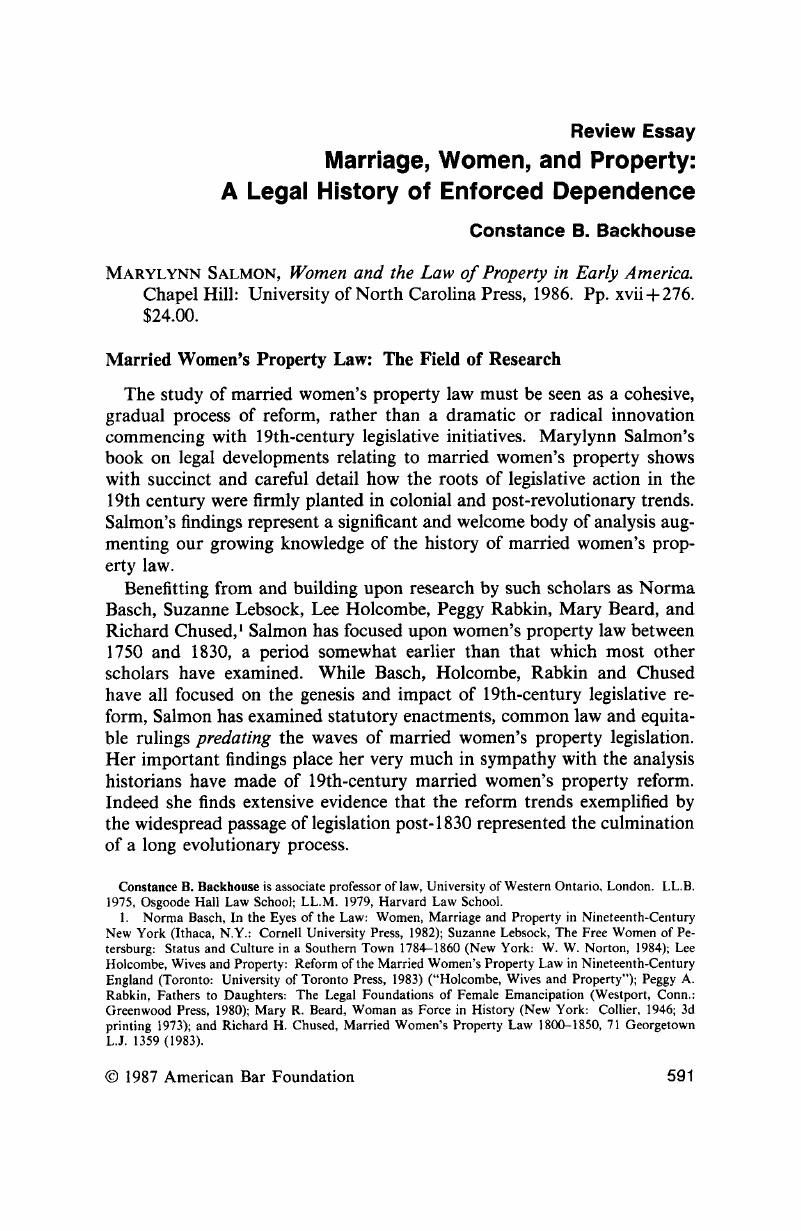No CrossRef data available.
Article contents
Marriage, Women, and Property: A Legal History of Enforced Dependence
Published online by Cambridge University Press: 20 November 2018
Abstract

- Type
- Review Essay
- Information
- American Bar Foundation Research Journal , Volume 12 , Issue 2-3 , Spring-Summer 1987 , pp. 591 - 600
- Copyright
- Copyright © American Bar Foundation, 1987
References
1 Norma Basch, In the Eyes of the Law: Women, Marriage and Property in Nineteenth-Century New York (Ithaca, N.Y.: Cornell University Press, 1982); Suzanne Lebsock, The Free Women of Petersburg: Status and Culture in a Southern Town 1784–1860 (New York: w. W. Norton, 1984); Lee Holcombe, Wives and Property: Reform of the Married Women's Property Law in Nineteenth-Century England (Toronto: University of Toronto Press, 1983) (“Holcombe, Wives and Property”); Peggy A. Rabkin, Fathers to Daughters: The Legal Foundations of Female Emancipation (Westport, Conn.: Greenwood Press, 1980); Mary R. Beard, Woman as Force in History (New York: Collier, 1946; 3d printing 1973); and Richard H. Chused, Married Women's Property Law 1800–1850, 71 Georgetown L.J. 1359 (1983).Google Scholar
2 Holcombe, Wives and Property ch. 2.Google Scholar
3 Constance B. Backhouse, Married Women's Property Law in Nineteenth-Century Canada: Common Law, Equity and Legislative Reform (manuscript, March 1986).Google Scholar
4 Backhouse, Constance B., Pure Patriarchy: Nineteenth-Century Canadian Marriage, 31 McGill L.J. 264 (1986).Google Scholar
5 Women preferred to have their petition on grounds of cruelty, desertion, or nonsupport.Google Scholar
6 Backhouse, , 31 McGill L.J. (cited in note 9).Google Scholar
7 Holcombe, Wives and Property (cited in note 7), has an equally excellent exposition of the rules of equity in ch. 3.Google Scholar
8 See, e.g., Barbara Leigh Smith Bodichon, A Brief Summary in Plain Language of the Most Important Laws Concerning Women, Together with a Few Observations Thereon (London, 1854).Google Scholar
9 See generally Chused, 71 Georgetown L.J. 1359 (cited in note 6); Rabkin, Fathers to Daughters (cited in note 4); Lebsock, The Free Women of Petersburg (cited in note 2).Google Scholar
10 Beard, Woman as Force (cited in note 5); Richard B. Morris, Studies in the History of American Law: With Special Reference to the Seventeenth and Eighteenth Centuries (New York 1959: orig. pub. 1930); Lawrence M. Friedman, A History of American Law (New York: Simon & Schuster, 1973).Google Scholar
11 See Basch, , In the Eyes of the Law (cited in note 1); Lebsock, , The Free Women of Petersburg (cited in note 2); Holcombe, , Wives and Property (cited in note 3); Rabkin, , Fathers to Daughters (cited in note 4); Chused, , 71 Georgetown L.J. 1359 (cited in note 6).Google Scholar
12 Salmon's Selected Bibliography provides a superb compilation of much of the relevant literature, at 239–51.Google Scholar




